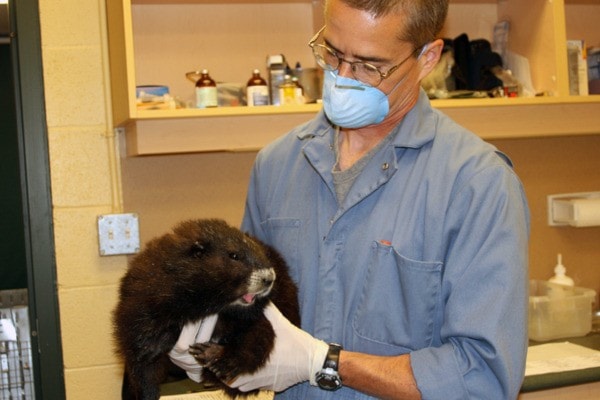Early in the morning, under bright blue skies, 17 marmots were released recently into the wild on Mount Washington.The Vancouver Island Marmot Recovery Foundation (VIMRF) and the Ministry of Forests, Lands and Natural Resource Operations released the final three groups of captive marmots onto the mountain, not far from its Tony Barrett Mount Washington Marmot Recovery Centre, as part of the ongoing efforts to rescue the Vancouver Island marmot from extinction and restore a healthy marmot population. While the marmots were released with optimism and hope, this has been a difficult year for the animals, according to veterinarian Dr. Malcolm McAdie, who gave the marmots a physical exam before releasing them."It's been quite a year in terms of weather," he said. "It was so cold for so long. Normally, we drive up to the facility in early May, but we weren't able to drive all the way until August. We sustained significant snow damage to the facility as well."The Tony Barrett Mount Washington Marmot Recovery Centre is celebrating its 10th anniversary this year.It is a breeding centre, and marmots born at other facilities in Langley, Calgary and Toronto will spend one year here prior to being released to give them the best chance of survival once they are returned to the wild.This year, the VIMRF released about 70 marmots, down from last year's high of 85. Most of the 85 marmots released last year went to Strathcona Provincial Park."Unfortunately, a large portion didn't survive because of that really bad winter," said McAdie. "We release them from captivity, and probably the hardest part is them getting through that first hibernation. If they make it, their chances of survival are really good."While many marmots did not survive the winter, reproduction was quite successful."Sixty pups or more were born in the wild this year," said McAdie. "We started out having this poor spring in terms of survival, but then breeding went well. One thing we're kind of faced with is trying to establish them in Strathcona Park; it's a bit more rugged than further south."Sean Pendergast, a wildlife biologist with the Ministry of Forests, Lands and Natural Resource Operations, has been involved with the marmot recovery program since 2001. He calls this year "a bit of a challenge," as they had to reorganize where they did their releases. They initially planned to release marmots in Strathcona Park in early July, but there was still snow, he explained."We did a bunch of releases to the south of the Island instead," said Pendergast. "We've now done three major releases into Strathcona Park this year with close to 20 animals. Today, we're releasing an additional 17 out on Mount Washington with the hopes of establishing them here in the winter where we can keep better tabs on them in the winter."Pendergast says they've had great success in the past relocating animals from Mount Washington to other sites on the South Island.In the south, the marmots are released in the Nanaimo Lakes area on mountains in the Nanaimo, Cowichan and Nitinat watersheds.Don Doyle is chair of the Vancouver Island Recovery Team and works for the Marmot Recovery Foundation.The recovery team was formed in 1988 to devise a strategy to recover all endangered species in Canada, and three have been created — in 1994, 2000 and 2008, explained Doyle, who took part in the release.The VIMRF was formed as a partnership of private forest companies, the provincial government and the public, according to Doyle."We have a very extensive public donor program that now exceeds the contributions of government and industry to raise funds to do the recovery strategy, captive breed, release them and try to get their numbers back up," he said. "We've been quite successful, from a low of 30 animals in the wild in 2003 up to 300, 350 in the wild. We've been very successful on the southern island, and we've just begun in the last three years working around Buttle Lake with contributions by BC Hydro."Doyle says they want 150 to 200 animals in three separate populations on Vancouver Island. Marmots' main predators are wolves, golden eagles and cougars, explained Doyle."We see very little predation here, I think because of the people here 365 days a year, and we don't see a lot of golden eagles here," he said. "Here in the early 1980s, you were hard-pressed to find a marmot on the hill, and now we have close to 60."Lupins and pearly everlasting are marmots' favourite food, and clearing the ski runs off at Mount Washington has provided them with lots of plants, noted Doyle.Doyle emphasized that the marmot recovery foundation and Mount Washington work together closely, and the marmots do not close the ski hill, as they usually come up in mid-May, and the ski runs are usually closed by then.Visit marmots.org to learn more about marmots and about donating to the VIMRF.writer@comoxvalleyrecord.com
